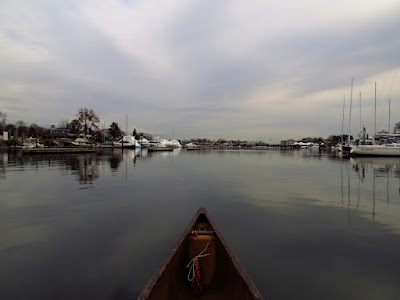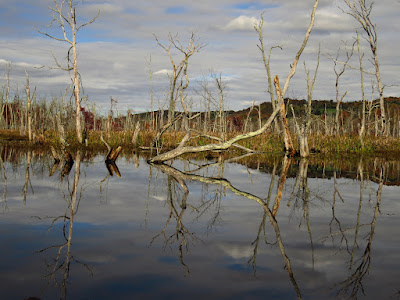I do the 200 yard portage from the house down to the sound and put in at the base of the neighborhood's seawall. It is foggy and calm with the temperature in the mid 40's. High tide passed about an hour ago and only the big seven foot boulder shows above the surface.
I head towards the town's harbor, which is about an hour away by canoe or by foot. The visibility is about a 1/4 mile or less. The in-the-house plan of circling Charles Island is put away as it is a mile off shore and at this tide level I might not be able to follow the submerged tombolo (a type of sand bar). Still, these are the best conditions for paddling the town shoreline because if sky is clear the trip dissolves into a tour of waterfront houses that are mostly built in the wrong places.
 |
| The mouth of Milford Harbor |
There is a very low swell - maybe only an inch or so. I would not notice it except that with nothing for the eyes to focus on, the other senses kick in. The swell is probably the almost dead wake of a boat that passed by a half hour ago and two or three miles off shore. Nearing Pond Point, I hear the industrial motor of an oyster boat somewhere well out in the fog. As I round the point the motor is closer and behind me. The clatter of oysters being dropped on steel signals that the boat is in its allotment.
At Welch's Point, the visibility drops to a hundred yards. I'm seeing a fair number of Red Breasted Mergansers and Brandts. I hear some other birds flying away, but they're able to see my shadowy figure before I can see them.
Oops. I was using my paddle as a coffee table while writing my notes, and when I grabbed my paddle to push me away from the shoreline oysters, my cup went into the water. Fortunately, the water is only two feet deep and I can reach in and retrieve it. Anyway, I cornered a Common Loon as I drifted into the mouth of the harbor - not intentionally, of course. Loons just like a huge safety buffer. This one flies off instead of the more usual submerged swimming evasion. The takeoff run is seven or eight canoe lengths - over a hundred feet. That is why Loons cannot take off from dry land.
 |
| Common Loon of of Pond Point |
Charles Island is just poking through the fog when I start heading home. I find a Loon near Pond Point and a second one near the west end of Morningside. I'm pretty sure that these spots have some tidal current - most of the Loons that I see here seem to be taking advantage of tidal currents.
 |
| Long Tail Drake |
I can hear the Long Tail Ducks calling from the fog when I take out and start the portage up the hill.

















































